1. Purpose of Laboratory Cleaning
The purpose of this Standard Operating Procedure (SOP) for Laboratory Cleaning is to establish guidelines and procedures for the cleaning and maintenance of laboratory spaces and equipment within [Company Name]. This SOP for Laboratory Cleaning ensures a safe, sanitary, and organized laboratory environment, supporting accurate research and testing.
2. Scope of Laboratory Cleaning
This SOP for Laboratory Cleaning applies to all laboratory personnel and covers the cleaning of laboratory workspaces, equipment, glassware, and utensils. It encompasses routine cleaning tasks and procedures for handling spills and biohazardous materials.
3. Definitions involved in Laboratory Cleaning
3.1 Laboratory:
A controlled environment used for scientific research, experiments, and testing.
3.2 Laboratory Personnel:
Individuals working in the laboratory, including researchers, technicians, and support staff.
3.3 Biohazardous Materials:
Substances that present a risk to human health or the environment due to their biological nature.
4. Responsibilities
4.1. Laboratory Personnel
4.1.1 Maintain a clean and organized personal workspace within the laboratory.
4.1.2 Properly clean and decontaminate equipment and glassware after use.
4.1.3 Report any spills or maintenance issues promptly to the laboratory supervisor.
4.2. Laboratory Supervisor
4.2.1 Ensure that laboratory personnel are aware of and follow cleaning procedures.
4.2.2 Coordinate regular inspections and maintenance of laboratory equipment and facilities.
5. Laboratory Cleaning Procedures
5.1. Routine Cleaning
5.1.1 Daily Cleaning:
- Wipe down laboratory benches, equipment, and frequently touched surfaces with a laboratory-grade disinfectant.
- Empty and clean waste containers regularly.
5.1.2 Weekly Cleaning:
- Perform a more thorough cleaning of workspaces, including the removal of dust and debris.
- Inspect and clean ventilation systems and safety equipment.
5.2. Glassware and Utensil Cleaning
5.2.1 Rinse glassware and utensils with distilled water after use.
5.2.2 Wash glassware and utensils with a laboratory-approved detergent, followed by rinsing with distilled water.
5.2.3 Autoclave or sterilize glassware and utensils, as required.
5.3. Handling Spills
5.3.1 Chemical Spills:
- Evacuate the spill area if it poses a risk.
- Follow the laboratory’s chemical spill response plan.
5.3.2 Biological Spills:
- Isolate the area and inform laboratory personnel.
- Follow established laboratory biosafety procedures for biohazardous material spills.
6. Biohazardous Material Handling
6.1. Biohazardous Waste
6.1.1 Dispose of biohazardous waste in designated containers following applicable regulations.
6.1.2 Decontaminate workspaces and equipment used with biohazardous materials after each use.
7. Laboratory Equipment Maintenance
7.1. Equipment Maintenance
7.1.1 Perform regular inspections of laboratory equipment.
7.1.2 Schedule preventive maintenance and calibrations as needed.
8. Documentation and Reporting
8.1. Records
8.1.1 Maintain records of cleaning and maintenance activities, including dates, personnel responsible, and any deviations.
8.1.2 Keep records for the specified retention period.
For more articles, Kindly Click here.
For pharmaceutical jobs, follow us on LinkedIn
For Editable SOPs in word format contact us on info@pharmaceuticalcarrier.com
For more information kindly follow us on pharmaguidelines.co.uk
Pharmacareer team is a team of Experts from every department of Pharmaceutical industry having enriched experience. Experts have work experience of many multinational pharmaceutical industries worldwide.


